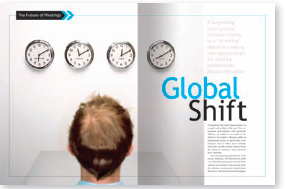Business Feature — GLOBAL SHIFT
A burgeoning international clientele, malady thanks to a “shrinking” planet, diagnosis is creating new opportunities for meeting professionals around the world.
By Elaine Rogers
 Globalization has made doing business on a small scale a thing of the past, cheap For corporations and industries with worldwide affiliates, no market is too small or too distant to be reached. Colleagues gather in international venues or spread their technological webs to offices across multiple time zones, and the meeting industry keeps the wheels of commerce—and connectedness— spinning.
Globalization has made doing business on a small scale a thing of the past, cheap For corporations and industries with worldwide affiliates, no market is too small or too distant to be reached. Colleagues gather in international venues or spread their technological webs to offices across multiple time zones, and the meeting industry keeps the wheels of commerce—and connectedness— spinning.
But with increasing globalization comes unique challenges. By following the paths of worldwide economic growth and developments in convention and meeting facilities, planners can maximize opportunities that exist in the international marketplace.
It’s a Smaller World After All
“Global markets have never been in such a sweet spot since 1945,” said Dr. Daniel Thorniley, senior vice president for The Economist Group in Vienna, Austria.
Identifying favorable economic signals that range from GDP growth, inflation and currency stability to government bond pricing, external debt ratios and trade figures, competition has significantly intensified since 2001.
“Slowly but surely, Chinese, Russian and Indian companies are stretching outside their domestic markets because they are cash rich,” Thorniley said. “Western executives are saying that companies from China and India are competing in many sectors—IT, software, consumer goods and engineering products.”
Even as more Chinese and Indian consumer goods appear on the market, Thorniley adds that Russia, the best performing market in CEEMEA (Central Eastern Europe, Middle East and Africa) for Western companies and the largest contributor to European Union export growth, “is set to explode” with business development.
“It’s a big shift of where business comes from—the new economies—and a breadth of new destinations to drive business to,” said Sebastien Tondeur, CEO of the corporate division for MCI, a pan-European association, communications and event management company headquartered in Geneva.
Feeling Hospitable
One of the largest growth industries is the hospitality sector. Recent MPI research places 65 percent of world economic growth in emerging economies and predicts the creation of 3.2 million hospitality sector jobs in China by 2015, 1.7 million in India and another 400,000 combined in the Gulf region and Singapore. That growth raises some unique opportunities for this industry. Luxembourg based Didier Scaillet, MPI’s vice president of global development, says savvy planners stand to benefit significantly since the hospitality industry is directly in the path of the activity, with 20 percent of the new hospitality sector jobs projected to be in meetings and events.
Business data collected by CHD Expert Group’s online group database for the luxury hotel industry (www.tophotelprojects.com) identify es 1,700 worldwide projects in the works—among them 600 hotel properties in continental Europe and the U.K.; 400 in Germany, Austria and Switzerland; and another 400 in East Asia and the Pacific. Hotel projects in North America and the Caribbean rank slightly lower, with a roster of 370, followed by 200 in the Middle East.
Exemplifying the trend, Hyatt Hotels Corp. has announced an ambitious expansion plan of international growth that will double its existing global properties— currently 735 hotels and resorts in 45 countries—over the next five years. With a nod to changing travel demands and liberalizing economies, Hyatt’s managing director of South West Asia, Peter Fulton, dubs his region the chain’s fastest-growing zone. Several key properties are targeted to open in the Middle East and India within the year, and Hyatt has 16 hotels under development in China and another five in Russia and the Commonwealth of Independent States.
Robin Lokerman, president of MCI Asia Pacific, says his company manages about 1,500 meetings a year, with 95 percent of them held outside the U.S.
 “There is a huge amount of meetings infrastructure development in the Middle East and Asia,” Lokerman said. “We see great growth in meetings and events in markets like India, China and the ASEAN (Association of Southeast Asian Nations) countries. Most of the meeting activity might not be international, but these growing economies are generating more national and regional meetings.”
“There is a huge amount of meetings infrastructure development in the Middle East and Asia,” Lokerman said. “We see great growth in meetings and events in markets like India, China and the ASEAN (Association of Southeast Asian Nations) countries. Most of the meeting activity might not be international, but these growing economies are generating more national and regional meetings.”
Taking to the Skies
Projections for worldwide air travel are on the rise as well.
Economist.com forecasts a total of 2.5 billion passenger departures worldwide in 2010—an increase of 500 million from current levels. Of those, 27 percent will be within Asia, 24 percent within Europe and 22 percent in the United States.
In addition, Airports Council International lists Dubai International Airport, currently the busiest in the Middle East, as one of the fastest-growing in the world. Between 2010 and 2018, its annual passenger capacity is expected to increase from 30 million to 45 million, while Jebel Ali International Airport is undergoing improvements and is slated to be the world’s largest by size when its Dubai World Center complex is completed.
Setting the stage for all this growth, burgeoning Arabic airlines are spending US$30 billion with Airbus and Boeing, increasing flight frequencies that mirror the sizes of their fleets. Research compiled by global futurist Rohit Talwar of Fast Future Ventures in London claims that Dubai-based Emirates Airlines is two years away from becoming the largest airline in the world, while Qatar Airways is slated to double its modest fleet by 2015. Emirates, with one of the youngest fleets in the sky, services 99 cities in 62 countries at present, but recently received the first of 58 superjumbo A380s ordered from Airbus’ Hamburg (Germany) facility, putting them on routes from Dubai to London, New York and Sydney. The company is also infusing its fleet with another 100 new-generation aircraft, proceeding with a growth mode that has tourism analysts talking.
Tough Times—Temporarily
Although recent concerns about higher fuel costs have led industry insiders to acknowledge recent cutbacks in extravagant corporate expenditures and respondents to MPI’s FutureWatch 2008 survey expressed concern about evidence of an economic downturn, industry professionals still adhere to bullish projections of an annual growth of 27 percent for corporate travel budgets. More than 1,600 professionals responded to this year’s survey, providing a definitive market trends study for the industry. Of note: outsourcing of meetings business is ranked at just one-fifth, yet the total still represents a 14 percent increase in volume.
“It’s rare to actually cancel a conference,” said Phoebe Boelter, chairman of the board of Conference & Publications Services LLC, a company that coordinates conferences for a variety of international organizations. “Since January, we’ve noticed that a lot of global companies are having their travel scrutinized more—their travel budgets are tighter—so they might send one or two people to a conference instead of three to four. There might be fewer people in attendance and it might be a smaller setup, but it will still be held.”
Lenny Spangberg, president of LSO International in Monaco, says he hopes the decrease in corporate events he has witnessed this year is temporary, but points to fuel costs and the falling dollar as significant issues affecting many of his clients’ meeting plans through 2008.
“Crossing the Atlantic isn’t very green, and it’s not always a very popular thing to do just for a meeting,” he said.
Meeting Pros Get Creative
Many of today’s challenges are opening up new opportunities for meeting planners, especially those who possess the skill sets required to deal with global happenings.
Even when corporate leaders schedule fewer trips or send fewer representatives to international gatherings, planners say they are increasingly turning to videoconferencing and teleconferencing technologies. Pharmaceutical giant Pfizer International, for instance, has 85,000 employees in 43 countries and plays host to a variety of regional conferences in zones such as Asia and the U.K., frequently sharing information between groups simultaneously.
 “Companies cut back in all sorts of ways in response to economic downturns,” said Pat Kelps, president of Global Destination Services LLC, a resource fi rm for the international destination marketplace. “But having concerns about fuel costs and expenses doesn’t translate to canceling the ways they do business or not having their meetings. They may not have as many paid dinners or they might choose a four-star hotel instead of a fi be-star property, but that might not matter that much to the people who are attending.”
“Companies cut back in all sorts of ways in response to economic downturns,” said Pat Kelps, president of Global Destination Services LLC, a resource fi rm for the international destination marketplace. “But having concerns about fuel costs and expenses doesn’t translate to canceling the ways they do business or not having their meetings. They may not have as many paid dinners or they might choose a four-star hotel instead of a fi be-star property, but that might not matter that much to the people who are attending.”
MCI’s Tondeur acknowledges that differences in currency rates “may have short-term impacts on incentive and meeting business,” but adds that conferences are typically planned several years in advance, meaning such factors only impact supplier margins.
“The global memory is short in a time of fast changes,” Tondeur said. He offers the opinion that recessional signals or even fears of terrorism have minimal impact on the modern mode of transcontinental commerce.
He offers the opinion that recessional signals or even fears of terrorism have minimal impact on the modern mode of transcontinental commerce.
“Outside of short-term incidents, I would not say that security impacts in a major way meeting destinations,” Tondeur said. “I would say that only U.S. groups are particularly sensitive about safety in regions known historically as unstable.”
Jane E. Schuldt, president of World Marketing Group, a Minneapolis-based firm that provides custom group travel planning, explains that higher fuel costs are simply “a new reality” to be addressed.
“Just as terrorism couldn’t stop people from moving who needed to move, fuel costs won’t either,” she said. “It’s something we’ll adjust to in a variety of ways.”
Boelter agrees, pointing to an inescapable and constant factor that bodes well for the meeting industry regardless of recent global challenges. “People need their face time,” she said. It’s a simple truth that knows no boundaries.
* * *
International Etiquette
Having a handle on the details is never more essential than when people travel far from home to congregate in unfamiliar destinations. Following are some items to keep in mind.
** English is widely considered the language of business, but when the venue is not on U.S. soil, using U.K. English rather than American English will be most appropriate for your printed marketing materials.
** When expecting intercontinental attendees, registration materials should be prepared with a longer lead time—at least six to 12 months—to allow enough flexibility to make extensive travel plans.
** Seasonal differences and time zones are critical factors. Prepare travelers for the expected climate and season of faraway locations, and take time differences into account when scheduling conference calls and teleconference link-ups with global partners.
** Meeting protocols should conform to the customs and norms of the region. For instance, although an 8 a.m. to 5 p.m. schedule is customary in the U.S., in many European countries, meetings start later and include longer lunches and later dinners.
** Celebrate local cultures. Providing information about a host country’s language, currency, cuisines and ethnic groups helps give visitors the lay of the land. Also, a Mexican fiesta might not be the best choice or a themed dinner in Belgium, and Japanese guests in Florida are more likely to get excited about sampling Cuban dishes than enduring an American take on sushi.
